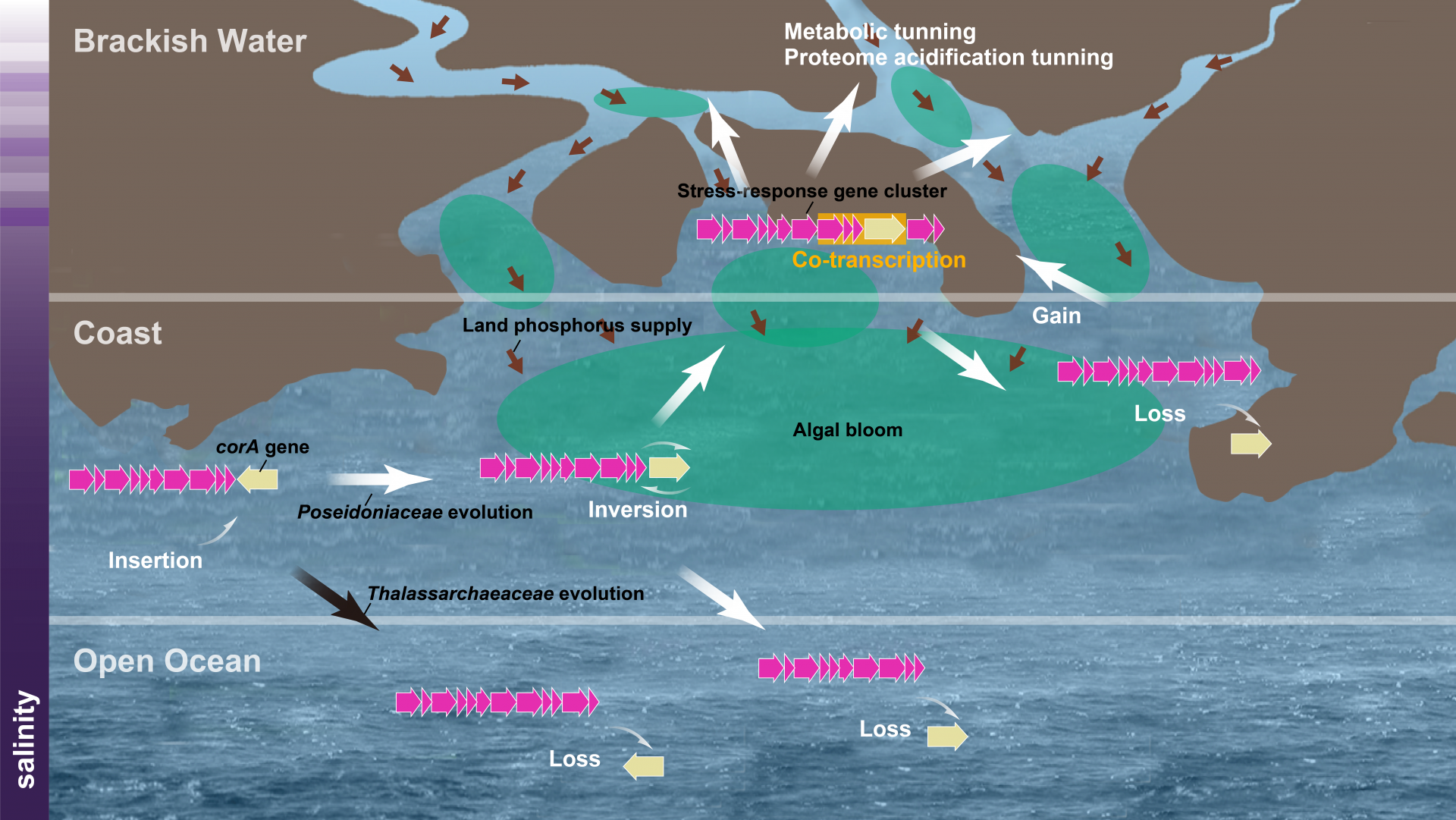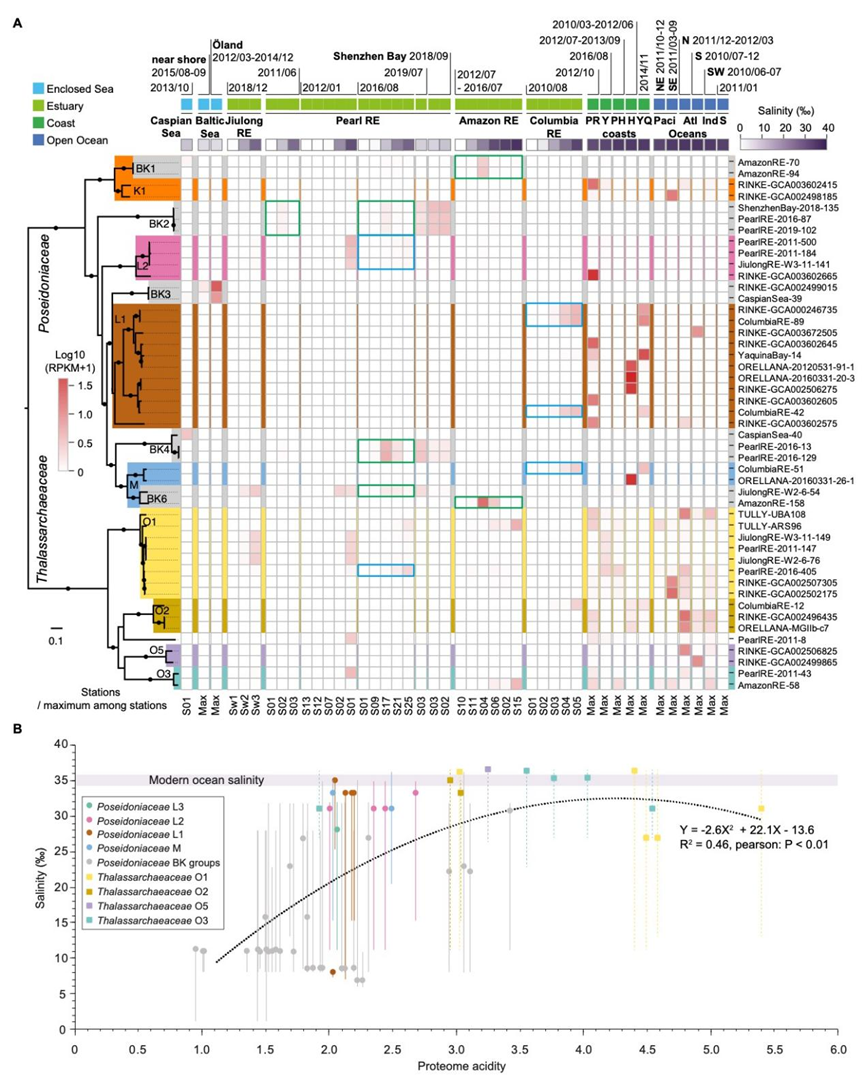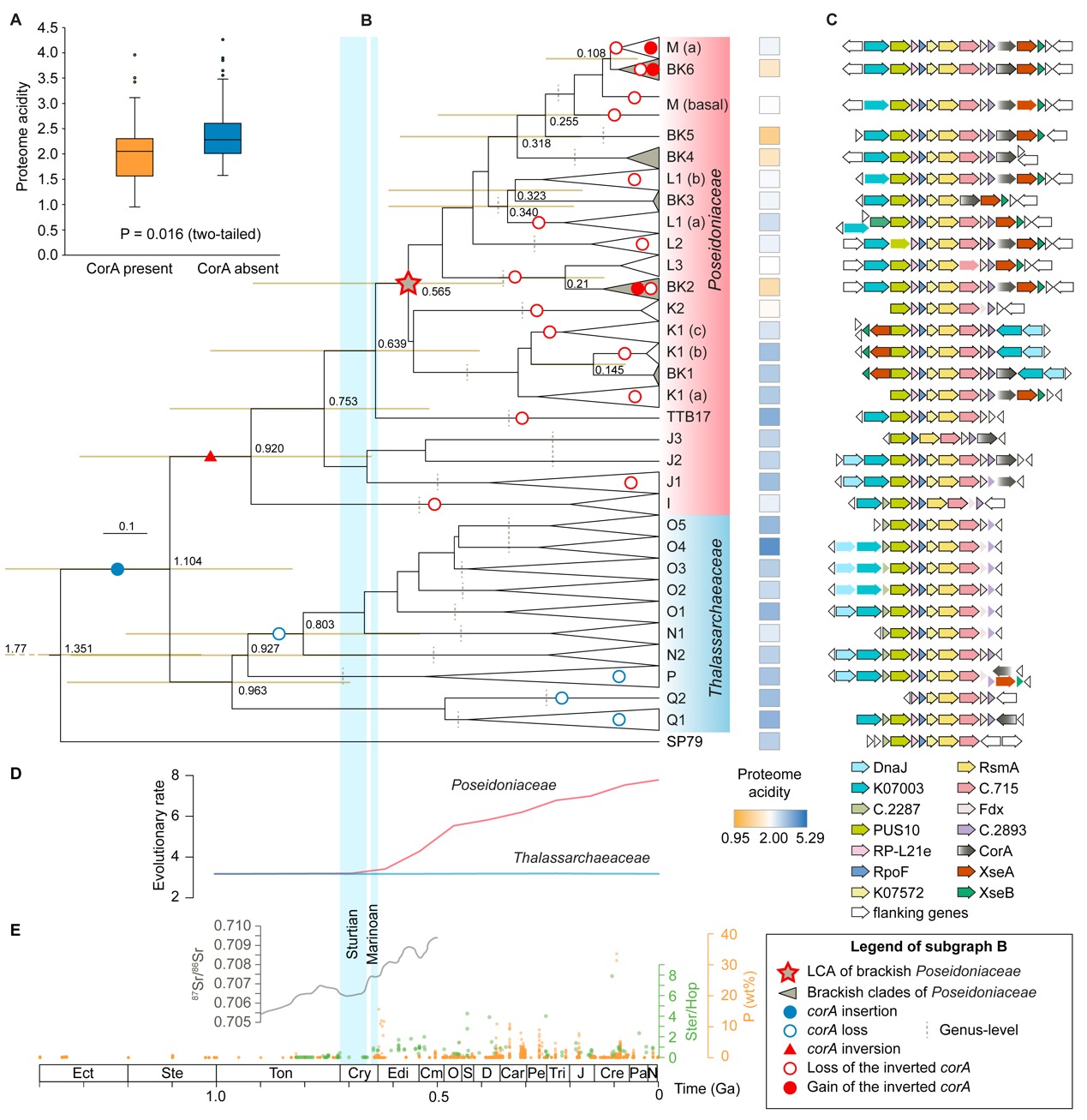Land-ocean interactions have strongly affected marine life evolution in the geological history of the earth. A typical example is the Cambrian explosion of animals, which happened largely on continental margins. The drastic shift of global biota is attributed to interconnected global changes after the Cryogenian Snowball Earth and in the Ediacaran-Cambrian transition (~700 – 485.4 million years ago, Ma), with rapid sea level rise, orogeny, and enhanced land weathering.
Salinity is among the strongest environmental factors determining the community composition of both macro- and micro-organisms, which is so-called the ‘salinity divide’. However, the geological forces and genetic mechanisms that drove the evolutionary transitions of bacteria and archaea between freshwater, brackish, and marine environments are still largely unknown.
Marine Group II archaea (Ca. Poseidoniales, MGII) are among the most abundant planktonic archaea in global oceans, playing essential roles in marine carbon cycles. Previously, Poseidoniales were considered widely distributed in global oceans with high salinity and not reported in either terrestrial soils or freshwater environments. Highly abundant Poseidoniales 16S rRNA genes were recently found at the estuary mixing zone with salinity below 15‰, suggesting the possible existence of brackish Poseidoniales populations.

A research team led by Chair Professor Chuanlun Zhang and Assistant Professor Lu Fan from the Department of Ocean Science and Engineering at the Southern University of Science and Technology (SUSTech) has conducted an innovative study on how land-ocean interactions drive the origination of the evolutionary trajectory of the brackish subgroups of Poseidoniales based on previous research.
Their work, entitled “Gene inversion led to the emergence of brackish archaeal heterotrophs in the aftermath of the Cryogenian Snowball Earth”, has been published in the multidisciplinary journal PNAS Nexus.
The researchers reconstructed 94 metagenome-assembled genomes (MAGs) of Poseidoniales from metagenomes of global estuarine, enclosed sea, and coastal environments. They revealed two distinct patterns of abundance distribution along the salinity gradient in Poseidoniaceae, a coastal inhabiting family of Poseidoniales: the ‘salt-preferred’ pattern and the ‘brackish-specific (BK)’ pattern (Figure 1). The monophyletic brackish (BK)-specific clusters in the phylogenomic tree, the less-acidified proteomes, and the distinct distribution pattern between marine and brackish Poseidoniaceae subgroups jointly suggest the long-term divergent evolution brackish-specific Poseidoniaceae.

Figure 1. Global distribution and proteome adaptation of brackish-specific and marine-specific Poseidoniales.
Further analysis demonstrated that ecological niche differentiation in brackish Poseidoniaceae was triggered by the inversion of the magnesium transport gene corA that conferred osmotic-stress tolerance (Figure 2). Co-transcription of corA with adjacent conservative stress-response genes may contribute to the adaptation of brackish Poseidoniaceae to the stress of salinity fluctuation in brackish environments. The insertion of corA to the common ancestor of Poseidoniales occurred from 1.351 to 1.104 Ga, and its inversion happened between 1.104 and 0.920 Ga. Notably, the common ancestor of extant brackish Poseidoniaceae emerged after 639 but no later than 564 Ma, covering the Marinoan Glaciation to the Ediacaran period. This period is also highlighted by the rise of eukaryotic algae, which might have enhanced the production of organic substrates for the growth of Poseidoniaceae.

Figure 2. Genetic changes, evolutionary rate, and geological background in the origination and evolution of brackish Poseidoniales.
The researchers finally proposed a general two-step mode of selection in the origination of brackish Poseidoniaceae at the land-ocean interface. The corA gene inserted to the end of an archaeal stress-response gene cluster in earlier time was inverted, providing a genetic predisposition for brackish adaptation. This was followed by the proteome being less acidified to meet lower average salinity, and the metabolism was better adapted to more near-shore environments. This gradual tuning in gene regulation, proteome amino acid composition, and substrate metabolism finally led to the origination of brackish Poseidoniaceae. On the other hand, some lineages lost the corA gene and returned to marine habitats. In some rare cases, they might further gain the corA genes, possibly through recombination and shuffle between marine and brackish niches in expanded shallow marine environments.
By studying the trajectory of archaea in the land-ocean interface, they could further understand the evolutionary history of life on Earth and provide insights for future responses to climate and environmental changes.
Assistant Professor Lu Fan, Ph.D. student Bu Xu, and postdoctoral fellow Songze Chen are the first authors of the paper. Lu Fan and Chair Professor Chuanlun Zhang are the co-corresponding authors. Other collaborators include Shenzhen University, University of Hawaii, Sun Yat-sen University, University of Queensland, Hainan University, China Second Institute of Oceanography, and Nanjing Institute of Geology and Palaeontology.
This work was supported by the National Natural Science Foundation of China (NSFC). Computation in this study was supported by the Centre for Computational Science and Engineering at SUSTech.
Paper link: https://doi.org/10.1093/pnasnexus/pgae057
To read all stories about SUSTech science, subscribe to the monthly SUSTech Newsletter.
Proofread ByAdrian Cremin, Yingying XIA
Photo ByDepartment of Ocean Science and Engineering